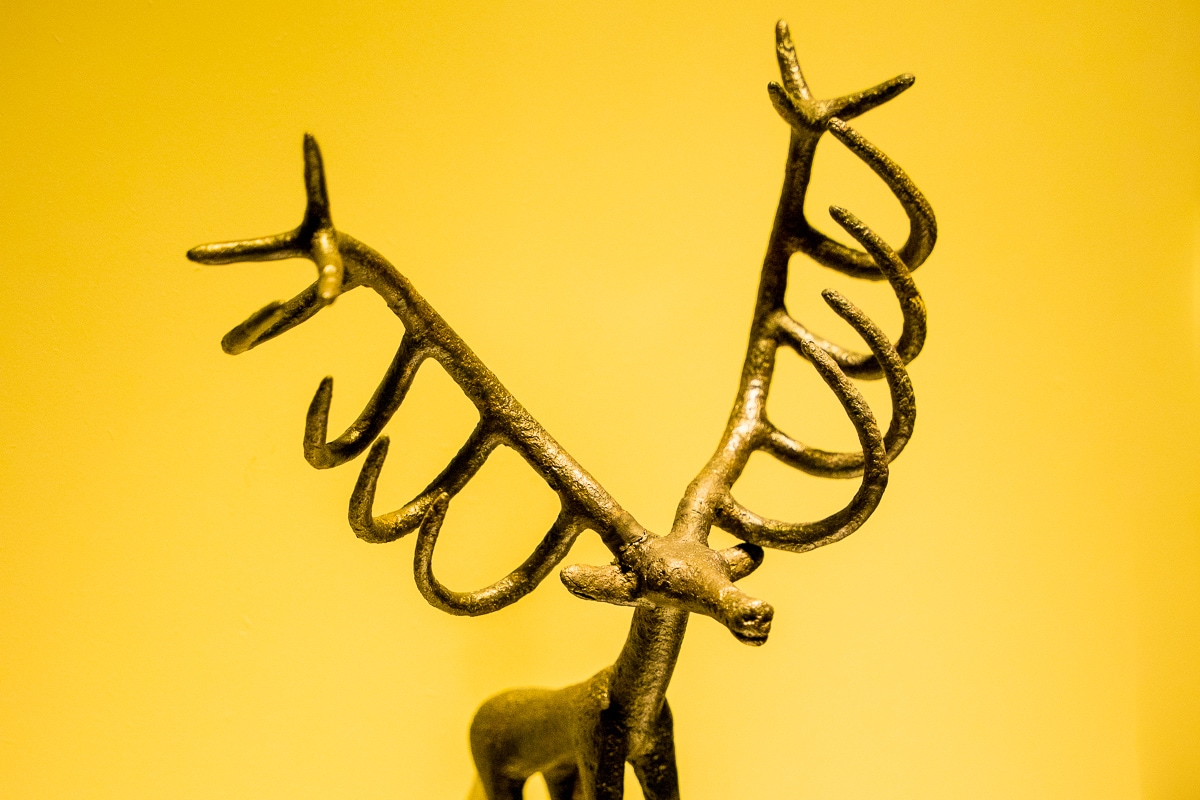Are you planning a trip to Ankara and worried that it might not match up to the cultural wonders of Istanbul? Fear not; we have found the one gem that makes Ankara worth visiting: the Anatolian Civilizations Museum.
We recently visited the museum on our Black Sea road trip, and it was the perfect way to end our adventure on a high note. The museum’s collection blew us away and really drove home the incredible history and age of this part of the world.
The Anatolian Civilizations Museum collection weaves together many civilizations, including the Hittites, Phrygians, Lydians, Greeks, and Romans. It counts among the most incredible archaeological treasures of Turkey/Türkiye (if not the entire world).
So, if you’re in Ankara or anywhere near it, don’t think twice and visit this extraordinary museum. We promise you won’t regret it! In fact, we’ll say it again: DO NOT MISS THE ANATOLIAN CIVILIZATIONS MUSEUM IN ANKARA!



Please note: This post may contain affiliate links. This means I may earn a commission if you make a purchase by clicking a link (at no extra cost to you).
Quick Guide to the Museum of Anatolian Civilizations
- Opening Hours: 08:30-19:00 every day ( last entrance 18:15)
- Address: özcü Street No:2 06240 Ulus (map)
- Parking: Available here (20 TRY for unlimited time)
- Entrance Fee: 150 TRY (210 TRY with audio guide)
- Tip: The Turkey Museum Pass allows free access to over 200 museums in Turkey, including the Anatolian Civilizations Museum
- Suggested Time: At least 2 hours. We only had 2.5 hours, and we felt rushed.
- Photography: Allowed (free)
History of the Anatolian Civilizations Museum

The Anatolian Civilizations Museum in Ankara was established in 1921 under the Turkish Republic’s founder, Ataturk, to preserve and display the Hittite artefacts, which had been scattered across different regions of Turkey.
Initially, the museum was housed in a section of the Ankara Castle. However, as the collection grew, it became clear that a larger space was needed to showcase the artefacts properly. In 1940, the museum was moved to its current location, which consists of two Ottoman buildings – the Mahmut Paşa Bazaar and Kurşunlu Han Caravanserai.
The museum holds an impressive collection of artefacts and artworks from various periods of Anatolian history, including the Paleolithic, Neolithic, Chalcolithic, Bronze Age, Assyrian, Hittite, Phrygian, Urartian, Greek, Hellenistic, Roman and Byzantine eras.
The bulk of the collection focuses on the art and culture of the pre-classical era, with incredible art from the Assyrians and Hittites being the highlight for us.
The museum’s collection includes a wide variety of artefacts, such as pottery, sculptures, coins, jewellery and many other objects that offer a glimpse into the daily lives, beliefs, and customs of the ancient peoples of Anatolia.
The extensive collection provides a fascinating and comprehensive look into Anatolia’s diverse and rich history and the civilizations that once thrived there. Today, it is one of the most visited museums in Turkey and a significant cultural institution.
It is one of the most interesting museums we’ve ever visited.
The museum was chosen as the European Museum of the Year (EMYA) in 1997. We agree it’s well-deserved but a little strange, considering Ankara is technically in Asia.
Collections & Exhibits in the Anatolian Civilizations Museum

The Museum of Anatolian Civilizations boasts an impressive collection of over 200,000 artefacts from the various civilizations that inhabited Anatolia. It covers a vast timeline from prehistoric times to the beginning of the Ottoman Empire.
The exhibits are arranged chronologically, starting from the Paleolithic era and continuing through the Neolithic, Early Bronze, Assyrian trading colonies, Hittite, Phrygian, Urartian, Greek, Hellenistic, Roman and Byzantine periods. I suck at math, but that’s more than 10,000 years of history under one roof!
It’s hard to choose, but the highlights of our visit were the Hittite artefacts and the Assyrian tablets with their cuneiform (the earliest writing system).
The Hittite Empire was one of the most powerful and influential civilizations of the ancient Near East, and the collection in Ankara is considered one of the most extensive in the world.
My Hittite fetish started after visiting the Archaeological Museum in Gaziantep last year. When I heard the collection in Ankara was even better, I knew I had to see it.
The Phrygian section of the museum is another highlight. The Phrygians were an ancient people who lived in central Anatolia during the first millennium BC, known for their distinctive pottery and metalwork.
Visitors can also explore a small selection of Greek, Roman and Byzantine art, which features impressive sculptures, pottery, and jewellery. These artefacts offer a glimpse into the cultural exchange that occurred between the Anatolian civilizations and the Greeks and Romans, who played a significant role in shaping the region’s history.
Visiting the Museum

Upon entering the museum building, visitors can explore the museum’s exhibits in an anti-clockwise direction, starting with prehistoric art from the Paleolithic age, which dates back 11,500 years. The displays continue through the progression of cultures over the next 9,000 years until you reach the Byzantine Period.
It truly is mind-boggling how old these things are, and even more astonishing how well they are preserved.
After seeing the pre-classical art on the ground floor, you will need to double back to near the start, where steps will lead you down to a small section with Greco-Roman era art.
Below are some highlights of our visit to the Museum of Anatolian Civilizations in Ankara.
Neolithic Fertility Goddesses


The museum wastes no time to get to the good stuff. After a few stone tools and weapons, which are a gazillion years old, we got to a collection of anthropomorphic figures of stunning obese women.
If you ever call your lover a goddess, you’re referring to these lovely ladies here.
These curvy ladies hail from Ҫatalhöyük near Konyak, one of the most important Neolithic sites in the world, and represent fertility. The terracotta figurines were made as human and agricultural fertility symbols and date from 5750 BC. These fertility figures are also known as Venus.
The most famous of the Venuses, the Goddess Figurine, is depicted sitting between two leopards, suggesting a robust social persona.
Bronze Age Objects from the Princely Tombs


Around 3000 BC, Anatolian people revolutionized metalworking by adding tin and alloy to copper, resulting in the invention of bronze. This new technology not only transformed the way they crafted tools and weapons but also influenced their art.
Many exquisite pieces from the Bronze Age were discovered at Alaca Höyük, which consists of 14 tombs. These tombs are collectively known as the Princely Tombs, and the artefacts uncovered here are considered cult objects.

We loved the striking stags and bulls, which have a timeless appeal despite being created around 2500 BC. In addition, two beautiful bronze figures of women represent a slimmer version of the fertility goddesses from the Neolithic era.
Tablets From the Assyrian Trade Colonies


Around 1960 BC, the Assyrians from Mesopotamia established trading colonies in Anatolia, bringing not only goods but also their language and writing system.
The section on the Assyrian Trade Colonies offers a fascinating glimpse into ancient commerce, politics and language.
The tablets feature cuneiform writing, one of the earliest writing systems, and will captivate code crackers, linguists, philologists and normal people like you and me alike.
The tablets have been deciphered, and translations in English and Turkish give a real glimpse into the lives of the ancients.
Among the many tablets are documents such as a marriage and divorce certificate, a list of taxes, a receipt for buying slaves, and a treaty between the King of Mama and the King of Kanesh.
We liked the detailed description of a marriage certificate of an Assyrian named Idi-Adad to an Anatolian named Anana. It prohibits Idi-Adad from marrying anyone else in Anatolia and specifies a penalty of five pieces of silver if he divorces Anana.
Vessels from the Hittites


The Hittites succeeded the Assyrians, who held power over Anatolia for roughly the next 500 years. The Museum of Anatolian Civilizations boasts an extensive collection of Hittite art, constituting most of the museum’s exhibits.
We loved the animal-shaped clay vessels used in ceremonies, which reminded us of the Tang Dynasty tomb treasures we saw in the Xinjiang Museum in China.
One particular container in the shape of two creatures with gaping mouths looked like something from an ancient psychedelic experience.
King Midas, the Phygrians & Urarto


Legendary King Midas, with his golden touch, is in the Museum of Anatolian Civilizations too. Artefacts uncovered from Midas’s tomb in Gordian, the capital of the Phrygian civilization, contain a few exceptional pieces of pottery and utensils featuring incredible craftsmanship.
Among them, my personal favourite is a bronze cauldron with four attachments shaped like sirens – creatures with a human head, arms, and shoulders but bird wings and tails. The intricate details of the engraved feathers and hair are still preserved perfectly after 10,000 years.


Following the Phrygian stuff, the Museum of Anatolian Civilizations features a collection of art from Urartu, an Iron Age Kingdom also known as the Kingdom of Van, located in eastern Anatolia.
Among the pieces is a striking iron cauldron with bull heads, which bears a striking resemblance to King Midas’s famed cauldron.
Reliefs From the Late Hittite Period



As you near the end of the exhibit of pre-classical cultures, you’ll arrive at the central hall featuring art from the late Hittite period. (Note-this is not the end-head downstairs to the classic-era art afterwards).
This stunning 10-domed structure was once a bustling bazaar and now serves as a breathtaking display space for the larger artefacts. These reliefs from 1200-700 BC offer the most iconic representation of Hittite art.
The massive slabs and bas-reliefs showcase themes of war with depictions of soldiers, chariots, gods, and powerful animals such as bulls and lions.
Classic-Era Art from the Greek, Hellenistic, Roman & Byzantine Period




To locate the classic era art, backtrack a bit to somewhere between fertility figures and bronze animals and look for stairs leading downwards. This small collection showcases a range of art discovered in the Ankara area, including marble statues, miniature bronze pieces, and exquisite golden jewellery.
The collection of miniature bronze figures is outstanding, with incredible details. The bronze head of Hadrian is so lifelike and almost looks like he will blink at any time.
We were particularly intrigued by the tiny tear bottles. Simply labelled as glass tear bottles, they are so small that you could squeeze two tears in them if you really wanted to. We still have to read up on what they were used for.
In addition, there is a remarkable assortment of coins from the Roman, Greek, and Byzantine periods.
Is the Museum of Anatolian Civilizations Worth Visiting?

Without a doubt! Our minds were utterly blown when we stumbled out of the exit. We knew Turkey was old. We knew people are awesome. We only realised how much after we visited the museum.
Whether you’re a culturally curious tourist, a historian, a linguist, an archaeologist, or a normal person like us, the Museum of Anatolian Civilizations has something to pique your interest.
A visit to the museum is an eye-opening crash course in mankind’s history, and the brilliance and ingenuity of the artefacts are proof of man’s brilliance.
The Museum of Anatolian Civilizations is a must-see when in Ankara. Do yourself a favour and set aside at least half a day to see the museum and experience the incredible collection of cultures spanning over 10,000 years.
It’s, without a doubt, among the best museums in Europe and, indeed, the world.
